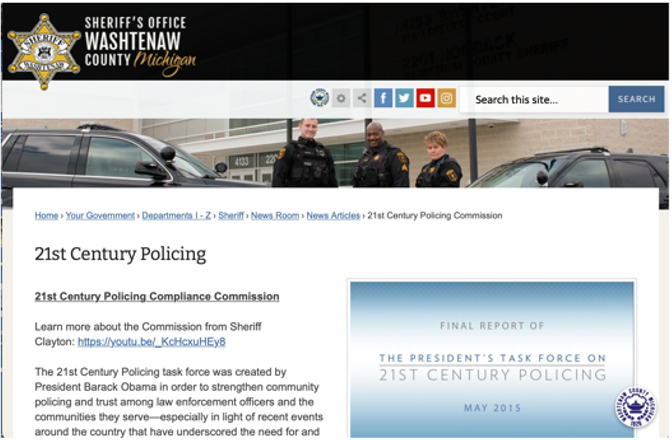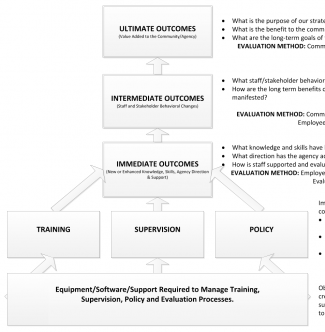
Case Study 4
Washtenaw County Sheriff’s Office
Building strong communities through quality public safety
and social justice services.
background
History
VIDEO
Beyond the Badge: Online Web-Series
-
Watch Full EpisodesWatch Full Episodes
Located in Southeast Michigan, Washtenaw County covers approximately 720 square miles. The county contains 27 cities, villages and townships in its urban, suburban and rural areas and is home to approximately 355,000 residents.1 Sheriff Jerry Clayton was elected to serve as Sheriff of Washtenaw County in 2008 (beginning service on January 1, 2009) and leads the approximately 400 person department which includes administrative operations, community relations, corrections, emergency services and police services divisions. The Mission of Sheriff’s office is to “create public safety, provide quality service, build strong and sustainable communities.2; In his online letter, Sheriff Clayton describes his core strategies as “providing community leadership, building partnerships and collaborations, focusing on service excellence and providing internal accountability.3
He has been a vocal proponent of the 21st Century Policing Task Force, the resulting report and the recommendations that it produced, using it as a ‘solid foundation,’ that has both confirmed ongoing efforts and encouraged other efforts to change the culture of the WCSO to focus on building healthy relationships and communities. These efforts led the NPF team to undertake this case study.
1. https://www.washtenaw.org/1557/About-Washtenaw-County
2. https://www.washtenaw.org/1124/Sheriff
3. https://www.washtenaw.org/1225/Letter-From-the-Sheriff
PILLAR 1
Building Trust & Legitimacy
Sherif Clayton’s leadership team is comprised of trusted individuals with diverse perspectives. He surrounds himself with people who look at policing through a variety of traditional policing and non-traditional lenses. When Sheriff Clayton was elected in 2008, he knew he wanted to outline ways in which the department could “focus on building strong communities through quality public safety and social justice services for all of Washtenaw County.”4 As part of that focus, he wanted the Sheriff’s Office community engagement efforts to align with a social work mentality. He wanted to establish a variety of ways to systematically engage with residents and establish two-way communication. As such, shortly

after taking over as sheriff, Clayton hired Derrick Jackson, a social worker by education and expertise, as the Director of the Community Engagement Division of the department.
At that time, Jackson had spent years working with the community on youth issues and was not particularly fond of police. He took on the role as a civilian Director of Community Engagement, went through the police academy and after 10 years continues to develop community engagement programs that build relationships with the community.
In partnership with Sheriff Clayton, Jackson is the architect of WCSO strategies that aim to garner community dialogue and trust and thus, the department’s legitimacy in Washtenaw County. He began by reaching out to impacted community members who least trusted and least wanted to engage with police. In addition, the Sheriff’s Executive Assistant, Ms. Wyatt is a trusted confidant and ‘the swiss army knife of community engagement.’ Her expertise, network and experience as part of the community provides the department with the knowledge to be thoughtful about who and how to include various parts of the community in WCSO work. More recently, the department has undergone a process to recruit, select and hire a Director of Diversity and Inclusion for the department. The hire process includes community feedback and focuses on hiring members of the community.
PILLAR 2
Policy & Oversight
Video
The 21st Century Policing Compliance Commission is a community-based, collaborative effort including community members and leaders, non-profit stakeholders, community mental and public health partners, faith leaders, education leaders, as well as Sheriff’s Office staff. The objective of this Commission is to work with WCSO in to achieve compliance with recommendations from 21st Century Policing Task Force.
In line with the 21CPTF report, WCSO does have many of their departmental policies on their website. While not all policies are included, many of those of most interest to the community, such as bias police practices, subject control/use of force, immigration enforcement and no-knock warrants are included on the site.
The department has a history of working collaboratively with community stakeholders to develop policy. Their Immigration Enforcement policy, for example, was developed in partnership with the immigrant community and is available to the public. WSCO developed a workgroup of local immigrants’ rights groups (WICR and SHOC), who wanted the WSCO to create a new immigration policy. They wanted to address immigration issues on the street and in the jail. Police officials, including the Sheriff, attended meetings with the workgroups, and explained what the law is, and what legal restrictions the WSCO was under. The drafting process for the policy was collaborative in that the WSCO and the two immigrants’ rights groups went back-and-forth on drafts of the policy. While the department does not use this collaborative process for development or update of every policy, they do so when policies are particularly impactful to the community.
Recently, the department launched the 21st Century Policing Compliance Commission. The commission is comprised of six subcommittees (aligned with each of the pillars) and include 40 to 50 members – equal numbers of community, staff and partners/stakeholders including justice involved individuals. The framework for the effort is 21CPTF pillars and recommendations. The Commission will determine what compliance looks like, will assess where the Department is regarding compliance with recommendations within each pillar (using quasi-monitoring methodology), and will provide recommendations on what is necessary to move forward. The Sheriff wants to convey that the commission should use the idea of working toward ‘ultimate outcome’ or what is the spirit of the recommendation. From this work, the department created a public facing dashboard that provides policing data to community.
PILLAR 3
Social Media & Technology
To the extent that WCSO incorporates technology that facilitates the tenets of community policing, procedural justice and engagement, the department does follow the 21CPTF recommendations. In his interview with NPF, Sheriff Clayton stated that WCSO doesn’t focus much on fancy technology. The department uses the Internet and social media to amplify or communicate their ongoing work, efforts, events or to otherwise communicate with the community. They use social media, including Facebook, Twitter and Instagram to update followers on important situations, investigations and other information. They also leverage the platforms to

promote information about the work they do in the community. The WCSO YouTube channel contains videos that provide information on many of their programs so that community members are able to see what they can expect to experience. Indeed, the department actually highlights the 21CPTF on their website and explains the pillars therein – again using it as a framework to communicate the departments priorities.
WCSO has also installed in-car computers and printers for deputies for better customer service, to streamline processes and so that better information is collected and input directly into the records management system. The department has also incorporated body worn cameras (BWCs) into their operations and ensured that their BWC policy is publicly available.
Pillar 4
Community Policing & Crime Reduction
VIDEo
Director of Community Engagement, Derrick Jackson describes the Washtenaw County Sheriff’s Office Community Outreach Program.
To gauge an agency’s community policing and outreach efforts, it’s essential to ask the community for their perspective and experience. In that vein, the NPF team reached out to the Washtenaw community to get feedback. The community responses from Washtenaw County suggest a nuanced depiction of the Sheriff Departments’ community policing efforts. While there have been restorative efforts congruent with the 21st Century Policing recommendations, some in the community, particularly the Black community, remains distrustful of the department.
One Washtenaw community member stated that, whereas previous Sheriffs had not maintained good relationships with the community, current Sherriff Jerry Clayton has made conscious efforts in amending and creating productive relationships with Washtenaw’s community. The community member noted that Sherriff Clayton “started one of the most progressive restorative justice Sheriff Departments in the country,” though he also noted that the progress is limited in scope and pace. Another community member labeled the relationships between the Sherriff’s Department and the community as “strained and built upon years of mistrust”.
When asked about their thoughts on the guardian vs. warrior mentality, and how they perceived Washtenaw’s sheriff deputies behaved in relation to this concept, one community member believed that Washtenaw’s Sherriff Departments’ philosophy to policing has improved under Sheriff Clayton, specifically that there is a greater emphasis on respect, dialogue, and supporting people in community rather than seeing themselves as an occupational army. However, he also highlighted that there are still those who see themselves as “warriors” or “blue soldiers.” In that regard, several community members said that the Sheriff Department did not behave as “guardians.” One member stated: “[the guardian mindset] is not being practiced – that’s one of the biggest things that we protested about. Your job is to protect and serve your community… If they came [into our communities] with a partnership in mind, as a guardian and with the priority to protect, I believe they would turn relations around with the community.”
The case of Sha’Teina Grady El was mentioned numerous times as an example of why the relationship between the Black community and the Sheriff Department is currently strained5. Several members of the community stood by Ms. Grady El, claiming that such a situation confirms the need for de-escalation training, particularly amid a time of high racial sensitivity between Black civilians and white law enforcement agents. One community member felt that deputies approach situations with Black civilians with an already heightened level of aggravation, therefore escalating situations that do not warrant escalation. Another community member noted that deputies need to understand why Black civilians are scared.
We further inquired about the community members’ knowledge and opinions on police trainings. Several members indicated that although current trainings are not robust enough, they were aware that de-escalation and implicit bias training were starting to be implemented in the Sheriff Department. Other members indicated that the way some deputies behave is not a matter of training, rather “it is a matter of heart, you can’t teach a good heart”.
Although community members acknowledged Sheriff Clayton’s recent reform initiatives, including establishing a 21st Century Policing Compliance Commission board and a Diversity, Equity and Inclusive committee in July 2020, some community members remained skeptical, and believe that issues of proper accountability remain a big concern. “Issues of racism and lack of integrity overshadow any good that comes out from the department”.6 Others expresses worry that police unions could be stifling any progress that Sheriff Clayton initiated.
Overall, community members recognized Sheriff Clayton’s efforts in improving community policing, yet they were clear that such efforts were not enough if cases such as Ms. Grady El’s are still befalling. Washtenaw’s community does not want the new 21st Century Policing initiatives to become ephemerous responses to the current negativity toward the police. They want permanent efforts for increasing accountability and implementing a long-standing community-centered philosophy in WCSO
5. More information can be found here: https://www.mlive.com/news/ann-arbor/2020/06/michigan-attorney-general-reviewing-case-where-washtenaw-deputy-punched-womans-head.html
6. https://www.clickondetroit.com/all-about-ann-arbor/2020/07/16/washtenaw-county-sheriffs-office-announces-new-role-police-reform-oversight-changes/
PILLAR 5
Training & Education
Department Personnel Professional Development

WCSO regularly includes community stakeholders and community members in training in a variety of ways. As an example, deputies shadow mental health workers and mental health workers shadow deputies to provide a view from each other’s perspectives. Community partners are included during the hiring process, and also participate in trainings, role playing to provide practical application of concepts learned in training. This inclusion provides both community members, stakeholders and deputies with a variety of perspectives and input on training objectives.
Another interesting and critical part of WCSO’s training is the community education provided on police policy, protocol, and practices as well as on the department’s efforts toward implementation of the 21st Century Policing Task Force concepts. The department provides ongoing community training through their Community Education Series, the Police Reform Academy, and by including community members in their hiring process, cross training during Problem Oriented Policing Conferences and through their 21st Century Policing Compliance Commission. The Community Education Series where community members learn about recruitment and hiring, training, subject control and use of force, accountability practices, hate crimes, body worn cameras and more.10
The Police Reform Academy is designed as a multi-week immersive learning series that aims to deconstruct the most pressing topics of police reform (Training, Use of Force, Hiring, Promotions, Discipline, Leadership, Culture, Policy, Engagement, Unions, and Current Reform Efforts) in order to implement effective change strategies.11 The sessions are not intended as a mechanism to push any one particular reform idea, but instead are solely focused on sharing knowledge related to current policing structures. These community education programs enable a more level playing field regarding policing for a balanced exchange of insights and ideas.
8. NPF Team (Jen Zeunik) interview with Eric Waddell. December 16, 2020.
9. Managing Interpersonal Interactions Series. Document provided via email to J. Zeunik from Eric Waddell on December 17, 2020.
10. https://www.washtenaw.org/1650/Community-Education-Series
11. https://www.youtube.com/watch?v=w4nhRVvicMM
PILLAR 6
Officer Safety & Wellness
Conclusion
Lessons Learned, Challenges, & Next Steps for Policing
As mentioned previously, Sheriff Clayton and his team have used the 21CPTF report to create the framework for creating and sustaining organizational change. When discussing the lessons learned from implementation of the 21CPTF report recommendations with Sheriff Clayton and other members of the WCSO, several lessons learned, challenges and potential next steps that they suggested.
Even after 12 years in office, Sheriff Jerry Clayton will tell you that the changes at the Washtenaw County Sheriff’s Office is on-going. It is a constant process of evaluating the needs of the community and implementing changes in the department to meet those needs. While many of changes have been successful and even some of the most distrusting community members acknowledge the changes, the department is still a work in progress.
Lessons Learned
Approach implementation of the recommendations with a focus on the final mission/goal.
Several members of the WCSO leadership team interviewed by the NPF Team discussed the need to work toward the ‘spirit’ or ‘intent’ of the recommendation, as opposed to implementing recommendations in a way that simply ‘check the box.’ Organizational change is long term mission that must be approached intentionally and continually. When asked about those in the department who are resistant or counter to change, they said that personnel either understand and get on board or they find other professional opportunities.
WCSO leadership universally discussed the 21CPTF recommendations as a framework through which the department created the architecture for organizational change in each of the pillar areas. Each suggested, however, that the it is up to individual department leaderships to determine how to ensure department decisions, systems, policies, protocols and practices fit into that structure and are working toward the ultimate mission.
Policing can be extremely insular, often relying on each other for ideas, support and best practices. However, police often see situations through the same lens, preventing other perspectives from influencing decisions. For this reason, Sheriff Clayton intentionally identified and hired individuals with non-traditional, often non-policing backgrounds to assist in shaping Washtenaw’s organizational culture.
Challenges
Culture is an exceptionally difficult thing to change, especially in policing. The culture in many police organizations has been intentionally built over many years as a way to keep officers safe and to build trust internally so that officers can depend on each other when they are in dangerous situations. Police and community leadership need to view changing that culture even more intentionality to refocus on priorities that incorporate fair and just policing.
Report & concepts lack strategic guidance on organizational and culture change.
Potential Advancements
Culture is an exceptionally difficult thing to change, especially in policing. The culture in many police organizations has been intentionally built over many years as a way to keep officers safe and to build trust internally so that officers can depend on each other when they are in dangerous situations. Police and community leadership need to view changing that culture even more intentionality to refocus on priorities that incorporate fair and just policing.
Acknowledge and address the role of leadership in organizational change
Leadership at all levels is imperative for reform. At the federal level, fluctuations in social policy and resource provisions can impact areas of community and departmental priorities. State and municipal leadership have an enormous impact on police reform. Chiefs work at the discretion of city leaders and are often at their mercy when it comes to resources. Non-partisan resources for state and municipal leaders, perhaps even a TF report geared to toward them and their priorities and challenges, would be helpful in pulling them into the conversation.
Sustained departmental leadership in reform is also critical. Most law enforcement CEOs last approximately two to three years. It is important to find a way to provide continuity of efforts and stability of organization. Sheriff Clayton has been in office 12 years and still isn’t finished – reform is a long term endeavor. Next steps in task force efforts need to ask how to make reform transcend leadership changes? Some steps may include ensuring executive searches for chiefs include requirements for competencies of 21stCentury Policing. Additionally, leadership development within the organization is important to engrain the changes and sustain leadership focused on progress.
Cover Photo Source: Washtenaw County Sheriff’s Office Instagram Account